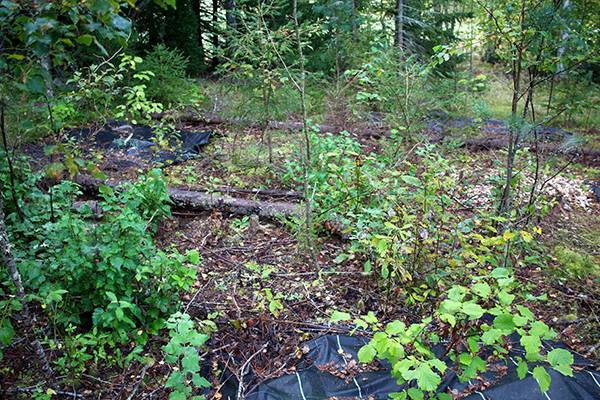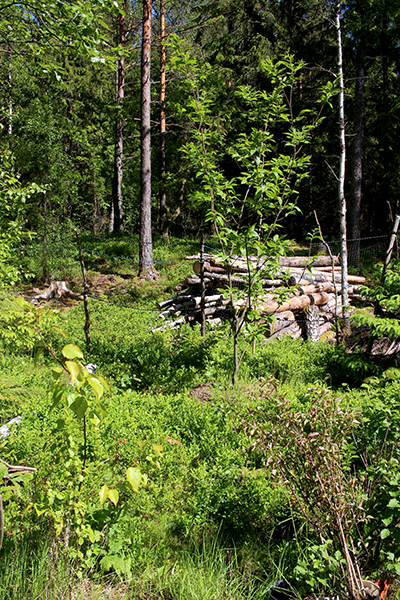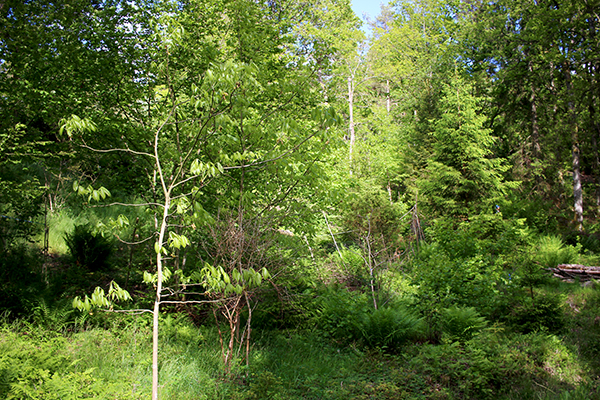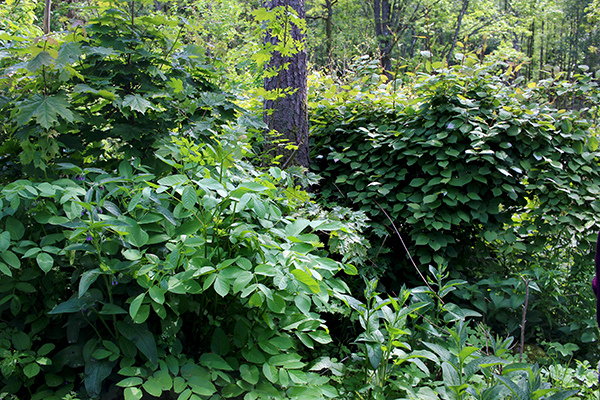One of the more common questions I get is how to do if you want to build a woodland garden with an existing forest as a starting point. Unfortunately, I do not know so many references for this procedure in our climate. Therefore, the most theoretical reasoning in this post and I am as usual grateful if readers want to share their own experiences.

The first question to ask is: Is it really here, I will build my woodland garden? The greatest benefit allows the woodland garden as known at the most disturbed and at least biologically valuable lands and it would be a shame to destroy an existing ecosystem by making it into a woodland garden.
Another place criterion is that any construction of its forest garden deep and fertile soils. Leaving aside arable plants growing Swedish forests generally on the poorer soils, which is often rocky and meager moraine soils with a pH value that does not fit many forest garden plants.
Would you still embark on the making of a forest to timber gardening, it is important to first let in more light to the ground. Among Forests provide a better starting point than the coniferous forests, because the right of fungi found in the soil and the pH value is probably closer the value we wish. Although a suitable örtflora (ie one that is compatible with the forest garden trees and shrubs) can often already be in place.

Trees that are very competitive root system (as birch, aspen and willow) needs to be removed, at least in a larger radius around the forest garden trees to be planted. The other trees can remain and serve as amträd for the newly planted trees. From protects from wind and radiation losses nighttime. Pine and oak have been shown to work well with many forest garden plants, but also spruce trees here and can work. Fir trees to the north protects from the cold north winds and raises the temperature on the sunlit side through its heat retaining ability.
Many interesting woodland garden plants, such as walnuts (Juglans spp.), hickory (Carya spp.), pawpaw (Asimina triloba) and hazel (Corylus spp.) are adapted to grow in semi-shade under large trees and many other plants, particularly in örtskiktet, are much more comfortable in the forest environment than in the sunlit environment found in most young forest gardens. If it turns out that these plants are not coming off despite having put aside competing trees may be due to rotkonkurrensen still too large. Then you need to thin out more and maybe take away some of amträden.

It is perhaps the biggest advantage to establish a forest garden in the woods is that you do not have to keep on fighting grass the same way that if you start with a grassy area. The establishment of both trees, shrubs and herbs will be much easier this way and it is not needed as much cultivation work in such a situation.
That which can be labor intensive, however, to improve the soil so that demanding forest garden plants can thrive in the long run. It takes a long time to build up sufficiently thick layer of soil and a solution can be to carry into the ground at each planting round. Even the water supply can be a challenge and it is important to study the location thoroughly before planting. In the hollows and valleys, water is rarely a problem, but in many slopes and ridges (which is often characterized by barren vegetation) can the water supply be too small to build a functioning forest garden.

In summary, you learn then face other challenges if it wants to establish a forest garden in a forest than assuming grassland. Also missing is today documented knowledge of such situations and there is much left to learn. So you who have experienced this, Please write something in the comments section to this post, or e-mail me at philipp@ihop.nu.



Hej Philipp! We have filed a skogsträdgård in a forest. Read more about it on http://www.östängsgård.se We did it as a course in the spring so our experience is very limited. We had Bosse Blomqvist as course leader and his own forest garden must be one of the oldest in Sweden lies in Grabo, near Gothenburg, also assume a forest.
Hi Ylva!
What fun with so many images from your course! It is true that Bosses forest garden is one of the oldest and most of the pictures in this post are taken in his garden. Very inspiring place!
/Philipp
My forest garden adopts me into something resembling an afforested pastures. I really enjoyed the advantage of amträden to provide shelter and create good microclimate. Think they also provide a good life with fungi and bacteria. The only problem is that which covers the ground have to make large holes in the cover web.
Hej Philipp
Thanks for the interesting facts. I have begun to gradually convert a forest to include more edible. There is right now a giant elm tree that I planted about 20 years ago. Right next sitting a frösått apple trees of a Gala apple. It suffered badly from the drought this year, unfortunately,. Elderberry, Sibirisk ärtbuske, Hawthorn and several vildaplar there also, and some currants, gooseberries and blueberries. And several large pines. Hazel birds have helped so all around. The place is an old pasture, and the foundation is a terminal moraine, ground vegetation was quite sparse until we pruned trees, then took the grass a dreadful speed. Otherwise grew where herbs, strawberries and mezereon. During elm grows a dense carpet of Ground elder, but until dried down this year. I realize that I have to add more mulch the plants will thrive like this drying-year as we had this year and last year.
Interesting to read about the trees that want shade under the trees, I have including a black walnut awaiting planting, might want it to stay here. I also have a pawpaw, but dare to put it outside with us ? Hade nog tänkt mig att det ville växa i växthuset.
Det här är ett långtidsprojekt som jag jobbar på när jag har tid…som visst aldrig verkar finnas numera sen jag startade plantskola 😉 Man får skynda långsamt.
Lisa
Hej Lisa!
Tack för att du delade dina erfarenheter, how exiting! Det låter verkligen som du behöver öka mullhalten och kanske hitta fler sätt att hålla kvar vattnet i landskapet. Svart valnöt kommer nog att trivas i halvskuggan ett tag. Jag såg ett gäng pawpaw-träd på friland i zon 2 utanför Alingsås i somras och flera av dem hade frukt på gång, så det kanske kan vara värt testa för dig också!
Philipp
Tjo Philipp! Do you want to add that you should watch out for the Grail, if you are such regions. Showing probably pretty good water supply but with rotskotten and the extensive root system, you should probably call bark gray glands and wait 5 years before thinking of establishing anything in such a place.
Alder's a completely different story =)
Good, thanks for the comment Joel, I forgot! But check the comment on the post about kvävefixerare, Further north, it seems that gray alder is a little less worry: http://skogsträdgården.stjärnsund.nu/skogstradgard/kvavefixerare/.
Hej Phillip,
Our woodland garden in southern Småland be established in a “forest similar” area: It has previously been farmland (so all the stones are removed! :-D), but it has the passport itself in many many years and are “jumped in forest” (Do you have a similar expression in Swedish?). We have shed a lot of birch and willow (sales) and 'call’ en masse asp, as we harvest for winter. We made the same experience as Lisa this summer: When Birk came down, took the grass. The area is in walking shadow from a large linden and a large birch. We intend to let these stand for the time being. For spring, we begin to plant trees!